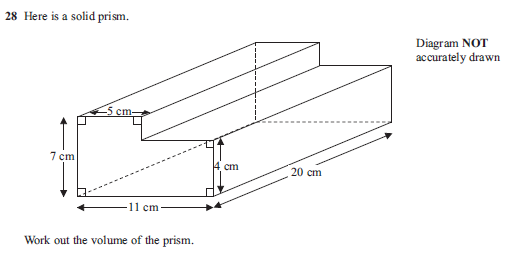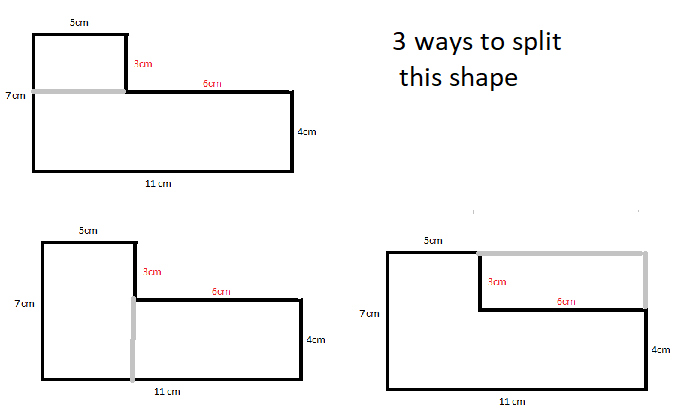Today’s post is a worked solution – of a question from straight off a GCSE paper.

With any question, the first ting to do is check if there are any words that are out of the ordinary. Here, the word that stands out is ‘Prism’
I first remember using a ‘prism’ in Science lessons, because a ‘triangular’ prism can do beautiful things with a beam of light. But that is a special sort of prism – one with a triangle at each end. Generally a prism is any solid shape that is the same all the way through.
And that is the clue to working out the volume. Work out the area of the shape of one end, and multiply that by the length.
That leaves us with the hard bit first – but at least we will know we’ve got that ‘out of the way’. How do we work out the area of the end, which is like an L lying on its side.
We need to split this up, but there are 3 ways of doing this. You might be able to see three ways of doing this; the third is a bit harder to spot.
On all of the splits, it will help you to fill in the missing sides. The short one we find by comparing the lengths on the left and right : 7cm – 4cm = 3cm
The longer missing length we can find by comparing the top and bottom. 11cm – 5cm = 6cm

I am showing the calculation for all three methods here BUT YOU WOULD ONLY NEED TO CHOOSE ONE!
The first split is into rectangles that are 5cm x 3cm = 15cm2 and
11cm x 4cm = 44cm2. Total is 59cm2.
The second alternative is 2 rectangles of 7cm x 5cm = 35cm2 and
4cm x 6cm = 24cm2. Total is 59cm2 – And the result should be the same of course!
The third is harder to see but I think quite clever. The area of the shape without the missing part is 7cm x 11cm = 77cm2. The missing part is 6cm x 3cm = 18cm2
. This time we have to take the second area away – its ‘missing’ 77-18 = 59cm2 . Like I said, this had to be the same answer, but its a good check that it is!
[That’s a good hint with any problem solving. If you want to check your answer, find it in two different ways. If you check an answer by repeating the same steps, there is a chance you’ll make the same mistake, if you made one]
The final step is to calculate the volume by multiply the area of one end by the length. 59cm2 x 20cm = 1180cm3
you forgot the 0 its 1180